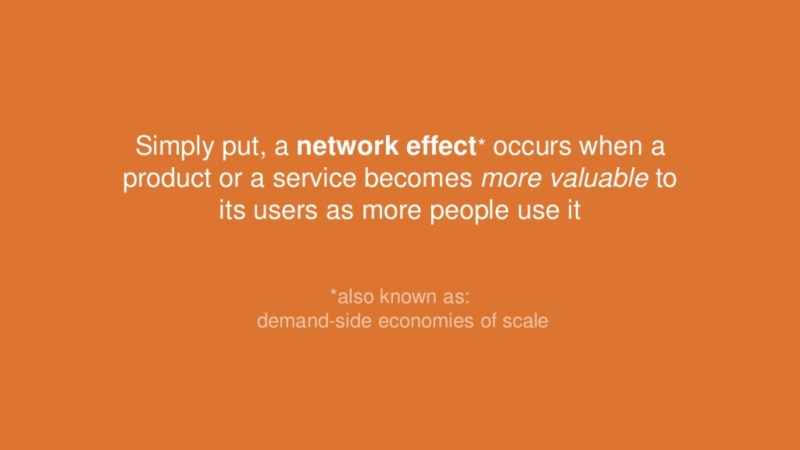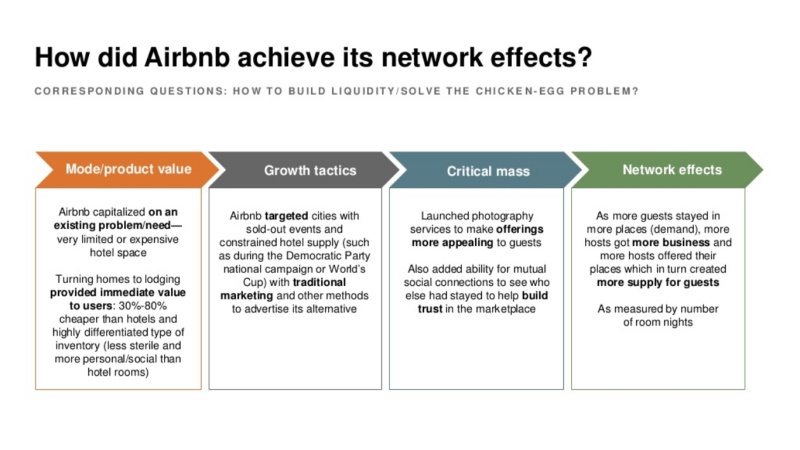eBay, Houzz, Etsy, and Airbnb are very different online marketplaces, but they all share one common trait that made them massively successful: network effects. An ecosystem that increases value for all its users every time a new user joins the community has been shown to be a critical success factor for digital platforms.
It is the main reason why Uber has a larger market capitalisation than either Ford or General Motors, and Airbnb is worth more than the Hilton and Hyatt hotel chains combined, despite being far younger companies.
“a network effect is the single most predictable attribute of the highest value technology companies”
James Currier, Silicon Valley entrepreneur and VC

Many marketplace entrepreneurs tend to lose sight of this core principle amid all the other much vaunted advantages of marketplaces. Not having to buy or manage inventory and being able to stock a greater variety of products are good and well, but it doesn’t help much if no one is buying what your vendors are selling.
Network effects amplify the liquidity in your marketplace by increasing the chances of a match between buyers and sellers. The higher the frequency of matches, the better the chances of creating unassailable defensive moats, also known as barriers to entry.
There’s even a technical law for the effect. Metcalfe’s Law holds that the total value of a network grows by the square of its size ( n2), where ‘n’ is the number of users.
Why your marketplace needs network effects
Although network effects sound like a modern term, they have actually been around for ages. When the first telephone network emerged in 1878, it created additional value for its users every time a new phone was installed. What has changed is how important they have become, especially for online marketplaces.
As global marketplaces like Amazon and Alibaba entrench their hold on global B2C and B2B retail and vertically-focused marketplaces mushroom, competition for consumers’ wallets will get more fierce. It has become crucial to differentiate your marketplace’s value proposition from that of competitors. As already mentioned, network effects can create those competitive advantages by promoting a higher ratio of matches between what sellers offer and what buyers want.
Another big advantage of focusing on igniting network effects, is that it cures the fanciful entrepreneur of the ‘if we build it, they will come’ syndrome. It forces marketplace owners to put the relationship between buyers and sellers at the core of the platform’s development, which means constantly analyzing user behaviour and using rapid iteration to establish product-market fit.
Network effects versus virality and economies of scale
Although a marketplace can contain elements of virality, network and viral effects are two different concepts with diverging goals. A product goes viral when the rate of adoption increases rapidly as more people are organically introduced by existing users. As we’ve seen, network effects are more concerned with the additional value, not volume, that is created.
Put another way, virality is about growth in numbers through referrals, while network effects are about growth in value through higher engagement rates. Some successful marketplaces, like Airbnb, often have low virality, but very powerful network effects. While virality can peter out suddenly when the fad had its moment, network effects are longer lasting and contribute to user retention and the defensibility of a business.
Economies of scale can affect either the demand side or the supply side. Supply side economies of scale kick in when products become cheaper to produce as a company gets bigger. Usually that is a result of fixed costs (warehousing, assembly lines) that remain the same as more goods are produced, or due to increased purchasing power that lowers the cost per unit.
Demand-side economies of scale is simply another way of looking at network effects. Since network effects dictate that a product becomes more valuable the more people use it, demand side economies of scale tend to be stronger than supply side economies of scale.
Not all network effects are created equal
Broadly speaking there are five types of network effects: direct, indirect, two-sided, local and global. Many digital platforms, including marketplaces, are able to leverage a combination of network effect types. Facebook, for example, makes use of all five.
Direct network effect aka same-side network effect
Each user adds to the value of network by way of their mere presence since everyone is looking for and receives the same benefits. Examples are social networks like Facebook and messaging apps like WhatsApp.
Indirect network effects aka cross-side network effect
Increases in usage of one product or network spawn increases in the value of a complementary product or network, which can in turn increase the value of the original. Examples include software and apps for operating systems such as Apple’s App Store, or secondary platforms that deliver additional services like Nestify’s property management services for Airbnb hosts.
Two-sided network effects
An increase in the activity of one group of users creates more value for another group of users. This is particularly true for buyers and sellers on marketplace platforms. Two-sided network effects are tough to compete with once they reach critical mass. Challenges: difficult to acquire users and you need to balance supply and demand. Examples include marketplaces like Houzz and Airbnb, as well as social networks like Facebook, where user attention and brand ads constitute the two sides.
Local network effects
Sometimes the value that is added is confined to a subgroup even if the total user base increases. In this instance, users derive value from the growth in numbers and activity of the smaller group. Local network effects can be seen in social networks like LinkedIn and on-demand platforms like Deliveroo. If more lawyers in Los Angeles join LinkedIn there’s no added value for a civil engineer in Sydney, but if more customers join in an area where Deliveroo partner restaurants are based, extra value is generated.
Global network effects
These tend to occur in international marketplaces like Airbnb that have few barriers in the form of language or payment. An apartment for rent in Paris is equally desirable for a tourist from Germany or Mexico. Some marketplaces like Uber can straddle both local and global network effects, since visitors from other locations also use local Uber drivers.
How do you build network effects on a marketplace platform?
To get the flywheel of momentum going is the holy grail of network effects. This occurs when a compounding feedback loop kicks in at what is known as a critical mass point. At that point the perceived value received from a product or service becomes greater than its cost. For instance, if enough good teachers join a peer-to-peer education marketplace like Skillshare, users will happily pay subscriptions because the value exceeds the cost.
It can be challenging to reach critical mass if the cost of adding value is very high. This is often the case with complex service platforms like Zillow, which has to spend a lot of money on buying, fixing and marketing properties. In their case, the answer was to increase commision rates.
Strategies for building network effects can be divided into a trigger stage and expansion stage.
Factors that can kick-start network effects
Build a system that is valuable to early adopters. Using an MVP to establish product-market fit is a smart way to get this done. Successful marketplaces don’t happen suddenly; they grow on the back of product iteration that is in turn based on user behaviour and feedback. Focusing on a niche vertical or single location initially makes it easier to solve product-market fit.
Introduce your product to the market with a freemium model that allows users to try out basic features for free. Once they become regular users make them pay for premium features or additional services.
Technical SEO can play a huge role in driving network effects by making it easier for users to discover and engage with your marketplace. For best results, design and implement a technical SEO framework when you start your marketplace.
Know what your critical mass goals are. Facebook established early on that each user required at least 10 friends to stay engaged. In the same way you need to know how many product options your buyers need or how many quote requests will keep sellers happy.
To solve the chicken or the egg problem, you can subsidise the side of your marketplace that is more challenging to acquire. Strategies that may work include free access, zero commission, and volume discounts.
Paul Graham, an iconic VC and co-founder of startup accelerator, Y Combinator, wrote a famous essay about the value of manual (non-scalable) activities to kick-start network effects. A great example is the effort Airbnb’s founders made to take photos of hosts’ properties themselves, to ensure good quality profile images and better conversion rates.
Triggering engagement with curation tools like ratings and reviews is a powerful network effects driver. Low-friction curation tools such as ‘likes’ and ‘favourites’ make it even easier for users to share their feedback with peers. Other engagement strategies are ‘refer a friend’ and suggested products or sellers.
Keep it simple. Make sure you have established product-market fit for your core value proposition before adding the bells and whistles. Too many extras can obfuscate which aspects of your marketplace platform users really want or are in need of improvement.
Users need to feel safe for them to be willing to transact on your marketplace. Trust generating mechanisms include ratings and reviews, guarantees, and a transparent payment system.
Expanding network effects
Once you have kick-started network effects, there are additional strategies to increase their impact.
Use data to tailor products and services to the individual needs and tastes of users. Investing in machine learning and the right data infrastructure can generate additional value in the form of personalised recommendations. This is something that Amazon and YouTube do very well.
Interoperability increases the size of marketplace networks by making it possible for other devices and platforms to connect and interact with it. This is a foundational principle of the Internet of Things (IoT). For example, almost 500,000 apps have been built with Amazon’s API, creating lots of added value for users of their platform.

Value can also be added by growing the on-platform services available to users. Opendoor is a managed (full-stack) real estate marketplace that not only connects buyers and sellers but actually buys your house upfront, before doing the maintenance and marketing to find a suitable buyer.
Focus on things that are working well. That means identifying and supporting products, locations, and target audiences that see the most activity and produce the best returns. E.g. how-to manuals and promotional services for performing sellers can boost their contributions even further.
A network effects case study
Airbnb is arguably the most famous example of network effects driving incredible growth in value over a short period of time. Our in-depth essay covers every step of the accommodation platform’s rise to world dominance. For a quick summary, have a look at the below graphic by VC giants, Andreessen Horowitz.

In general terms, the network effects process can be broken down as follows:
- Create immediate value for early adopters
- Drive engagement (refer a friend, curation tools, suggested products/sellers)
- Increase usage (product and UX improvement, new features) per user
- Network effects
Measuring network effects
It’s not enough to simply implement network effects strategies; you also need to measure how successful those strategies are at driving network effects.
Andreessen Horowitz identified five main categories to measure network effects: acquisition, competitor, engagement, marketplace, and economics-related metrics. Of course, marketplace businesses will measure different metrics based on the product or service verticals, users, and locations they are targeting.
Acquisition metrics:
Organic vs paid users. As the network grows and becomes more valuable for users, more users should be joining on their own rather than due to advertising.
Traffic sources. The higher the ratio of direct vs external traffic, the stronger the network effects. Yelp provides an example of the ‘come for the tool, stay for the network’ principle. Users initially search for a restaurant and then book via Yelp’s reservations widget on the restaurant’s website. Eventually they go directly to Yelp to search for restaurants and make reservations.
Customer acquisition cost. High CAC can be an indication of saturated markets such as found with ride hailing and can highlight the effectiveness (or not) of your marketing channels.
Competitor metrics:
Multi-tenanting. How many of your users also use other similar services and how active are they on those services? This can be determined by using surveys and countered with subscriptions and a superior user experience.
Switching costs. How easy is it for users to join another network and how much additional value can they get from joining a different network? The level of friction created by competing onboarding processes can either lock existing users in or chase new users away. The immediate value offered by, for example, job listing marketplaces, provides a powerful incentive to sign up to multiple platforms. Sellers will also compare the amount of time it takes for a lead or sale to take place.
Engagement metrics:
User retention. Are newer users (who signed up to a larger more valuable network) more active and loyal than older users (who signed up when the network was smaller and less useful)?
Core action retention. How many new users are completing your platform’s central activity, e.g. requesting a quote? Also known as a North Star Metric.
Paid user retention. How long do new users remain subscribed or continue to use paid products?
Retention by location. Users in older, more mature markets with denser networks should display better retention rates than younger less-developed markets.
Power user curves. Are users becoming more engaged over time? This can be measured by looking at the number of times a particular action (e.g. requesting a quote) was completed over a specific time period.
Marketplace metrics:
Match rate. How successful are the two sides of the marketplace at finding each other? Examples include the percentage of time ride-hailing cars are occupied with passengers, how often employers fill positions posted on job marketplaces, the percentage of shopping carts that are abandoned, and the ratio of successful vs unsuccessful quote requests.
Once the reasons why some matches don’t occur have been identified, steps can be taken to improve the product offering and/or user experience.
Market depth. Is there enough supply of services or products that fulfill users’ needs? In a heterogeneous marketplace with many different products or services this will be dependent on a user’s ability to find a specific match, i.e. a product they want to buy or a service they want to rent. Homogenous marketplaces rely on the ease with which a product can be accessed. Bike or scooter rental marketplaces, for example, should have enough bikes or scooters in the vicinity of potential users.
Time to find a match. How long does it take for supply and demand to match? This can be the time it takes an employer to fill a position via a jobs marketplace or how long it takes for buyers to receive their first quotes.
Concentration or fragmentation of supply and demand. The higher the fragmentation of a market (number of unconnected sellers and buyers), the more valuable the marketplace becomes. Concentration can be gauged by measuring the percentage of total sales that are driven by top sellers or buyers.
Economics-related Metrics:
Pricing power. How much are you able to charge for your service? As users receive greater value from the network, they are willing to pay more for access, in the shape of subscriptions, listing fees, commissions and other sources of revenue. Stronger pricing power makes it easier to increase prices without increasing the churn rate.
Unit economics are direct income and expenses associated with a particular business model, e.g. customer acquisition cost and customer lifetime value.
Future-proof your network effects
Increased competition in the online marketplace sector, due to easier marketplace creation options and faster product iteration cycles, has caused network effects to change at a rapid pace too. Today, a first-mover advantage does not mean the network effects-driven market domination it once did and in some instances network effects can even follow a negative trajectory. MySpace is a well-known example of reverse network effects that killed a platform.
To stay ahead of the competition you need to keep an eye on three important facets of your marketplace that can affect network effects: your value proposition, your users, products and/or services, and your competitive landscape.
Combat product saturation by creating additional value for users. Ubiquitous ride-hailing services like Uber or Lyft have realised that adding more drivers doesn’t add more value. They had to experiment with pricing and better customer support to retain their competitive advantages.
Sometimes marketplace network effects create lots of value for users, but are difficult to monetise. This holds especially true for so-called complete marketplaces like Foursquare and some event and job listing sites, where users expect comprehensive listings without wanting to pay for access. Offering a secure payment and shipping system to process transactions between buyers and sellers is one way to overcome this challenge.
Marketplaces with differentiated products or services have longer-lasting network effects than those with commoditised products or services. The diverse inventory of an Etsy makes it easier to cater to the unique tastes of multiple customers, while most users are agnostic about which ride-hailing company they use. That’s why Uber has differentiated themselves with new products like Uber Eats.
Of course, the more differentiated your product offering, the more emphasis there should be on the curation of high-quality products and services. Your users need to be protected against bad actors such as fraudulent sellers through mechanisms like transparent reviews or service/product guarantees. Airbnb has done this by creating a Trust and Safety team as well as offering a Host Guarantee in addition to peer reviews.
As mentioned in the metrics section, you can assess the level of competition in the market by staying on top of multi-tenanting and switching costs. Low barriers to entry and network overlap may necessitate a rethink of your value proposition. Craft marketplace, Etsy, managed to increase its revenue by 37% in 2018, despite competition from numerous copycat marketplaces, by focusing on free shipping and seller advertising tools.
Network effects are clearly powerful drivers of value and growth on marketplace platforms, but require an organised approach to set in motion and constant analysis to keep going. If you would like to know more about this complex topic and how to promote network effects on your platform, get in touch with us.
